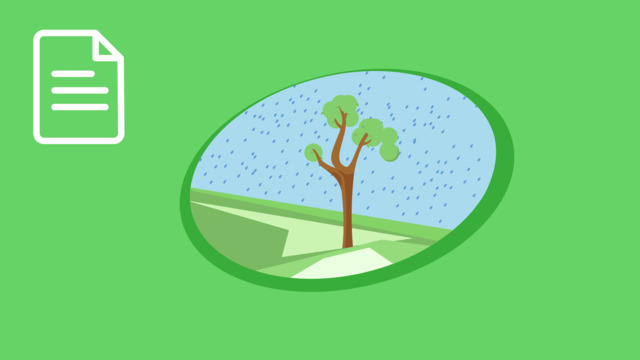Climate Around the World
- Climates Around the World – Introduction
- What is Climate?
- Climates of the World
- Climate Zones Map
- Tropical Climates
- Dry Climates
- Temperate Climates
- Continental Climates
- Polar Climates
Learning text on the topic Climate Around the World
Climates Around the World – Introduction
Have you ever wondered why some places are super hot and others are freezing cold? Or why some areas have forests while others have deserts? Today, we're embarking on a fascinating journey around our planet to learn about the different climates of the world.
Climate is like a big puzzle that shapes how we live, what we eat, and even the clothes we wear. By understanding climate, we can learn more about our amazing planet and the diverse life it supports.
What is Climate?
Climate is the average weather conditions in a place over a long time. It includes things such as:
- Temperature
- Humidity
- Rainfall
- Wind speed
Imagine the Earth wearing different outfits depending on where you are: a warm, sunny outfit for tropical places, a dry, breezy dress for deserts, and a thick, cozy coat for polar regions. These "outfits" are the Earth's way of showing us its climate! It is important to know that all of these climates are happening at the same time on Earth. A cold climate can exist in one part of the world, while another part of the world is experiencing a warm climate.
Climates of the World
Our planet has various climate zones, each with its unique features and weather patterns. All climates begin at the equator. The equator is an imaginary line dividing the Earth into the Northern and Southern Hemispheres. As you move away from the equator, climate changes from being tropical all the way to polar at the North and South Poles.
Let's explore the climates of the world!
| Climate Type | Temperature | Rainfall | Example Locations |
|---|---|---|---|
| Tropical | Warm | High | Amazon Rainforest, Brazil |
| Dry | Varies | Very Low | Sahara Desert, Africa |
| Temperate | Moderate | Moderate | London, United Kingdom |
| Continental | Extreme | Moderate | Moscow, Russia |
| Polar | Cold | Low | Antarctica |
Climate Zones Map
To understand where these climates are located in the world, let's look at a climate zones map:
Tropical Climates
Tropical climates are found near the equator and are known for their warm temperatures and high rainfall. These areas are full of life and are home to dense rainforests, diverse animal species, and beautiful landscapes. Cuba and the Amazon Rainforest are great examples of a tropical climate.
Dry Climates
Dry climates cover a large part of the Earth and are characterized by low rainfall, making them dry or semi-dry Deserts and grasslands fall into this category, where water is scarce, and life adapts to the dry conditions. Dry climates are often found in Africa and the Middle East.
Temperate Climates
Temperate climates are found in regions that experience a wide range of temperatures throughout the year. These areas have distinct seasons, with rainfall spread fairly evenly, such as the USA, UK, and some other European countries.
Continental Climates
Continental climates experience more extreme temperatures, with cold winters and warm summers. These areas are usually found inland, away from the moderating effects of large bodies of water, such as Russia or Ukraine.
Polar Climates
Polar climates are found in the regions near the poles, characterized by very cold temperatures year-round. These areas include the Arctic, Antarctic, and high mountain regions.
Climate Experiment
You can follow this experiment to create a climate.
Climates Around the World - Quiz
Climates Around the World – Summary
Key Learnings from this Text:
- There are 5 climate zones, namely tropical, dry, temperate, continental, and polar.
- Climate determines the average weather conditions of a place over a long time.
- There are different climate types, each with unique features like temperature and rainfall.
- Understanding climates helps us learn about the Earth's diversity and how life adapts to different environments.
If you want to learn about seasons, then check out Spring season, Summer season, Fall season, and Winter season
Frequently Asked Questions about Climates Around the World
Climate Around the World exercise
-
What is climate?
HintsThe word patterns means the usual ways that things like how hot or cold it is and how much it rains stay the same over a long time in one place.
We look at the weather over many seasons to understand what the climate is like in a place, rather than just what happens in a few days or weeks.
SolutionClimate describes the usual weather patterns, like temperature, humidity, wind, and rainfall, in a specific area over a long time.
Unlike the weather, which can change every day, climate is the average weather conditions measured over many years.
-
How do tropical climates differ from continental climates?
HintsTropical places are near the middle line of the Earth.
Tropical places have lots of rain and stay warm all the time.
Continental places are far from the sea and have big weather changes.
Places with continental weather get really cold in the winter and warm in the summer.
SolutionTropical climates are warm all year with lots of humidity and rain, and you often find big, green rainforests there.
They are close to the equator, which means they get a lot of sun and stay warm.
On the other hand, continental climates are found far from the ocean, more inside the land, and they have bigger changes in temperature.
These places have cold winters and warm summers because there aren’t any big bodies of water nearby to keep the temperature more steady.
-
What are the differences between dry and polar climates?
HintsPolar climates are where it's cold enough for lots of ice and snow.
Remember that dry climates are where you find deserts.
SolutionDry climates can be really hot in the day and cold at night, and they hardly get any rain, which makes it hard for many plants to grow.
You might see snakes, camels and lizards there.
Polar climates are always cold, and instead of rain, they get a lot of snow.
Not many plants can grow because it's so cold, but animals like polar bears and penguins can live there.
-
If you travel from the equator towards the poles, what climate change would you observe?
HintsThe climate around the equator is usually very warm and rainy.
It doesn't get too hot or too cold, and it rains a lot there.
Think about how it gets cooler and there's more snow and ice as you move from the hot, wet equator towards the very cold poles.
The weather changes from lots of rain in the warm tropical areas to less rain and more snow as you go towards the colder polar areas.
SolutionAs you go from the middle of the Earth (the equator) toward the top or bottom (the poles), the weather changes from hot and wet in tropical places, through cooler areas with different seasons, to very cold and icy in polar places.
This happens because it gets colder and the rain and snow patterns change as you move away from the hot sunlight at the equator to the colder parts near the poles.
-
Which of these things is not part of what makes up the climate?
HintsClimate is about the air and weather.
Think about the air and the weather when you think about climate, not the dirt you stand on.
SolutionThe correct answer is soil type.
Climate is about the weather over a long time, like how hot or cold it is, how much rain falls, and how humid it is.
-
Can you determine the climate?
HintsPay attention to the description of warm weather, frequent rain, and lush forests in the story.
These are key characteristics of one particular climate.
Consider the presence of colorful birds, animals, and dense vegetation mentioned in the story.
Which climate is often associated with these features?
SolutionThe correct answer is a tropical climate.
The story describes a place with warm weather, frequent rain, lush forests, colorful birds, and diverse animals, which are typical of tropical climates found near the equator.
This climate zone experiences high temperatures and humidity throughout the year, supporting dense vegetation and diverse ecosystems.























